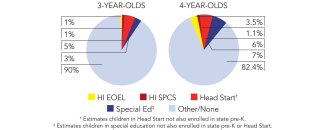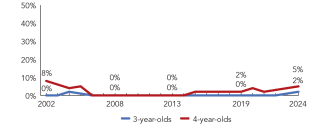
State of Preschool
Hawaii
Access Rankings
Resource Rankings
Total Benchmarks Met
Overview

During the 2023-2024 school year, Hawaii preschool enrolled 1,026 children, an increase of 322 from the prior year. State spending totaled $7,590,165, up $111,201 (1%), adjusted for inflation, since last year. State spending per child equaled $7,398 in 2023-2024, down $3,226 from 2022-2023, adjusted for inflation. Hawaii met 10 of 10 quality standards benchmarks.
What's New
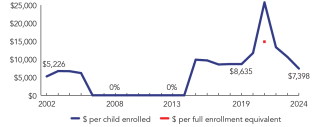
In 2023, Hawaii announced its Ready Keiki Initiative, which will to expand early learning opportunities for children and families. During the 2023 Legislative Session, the State Legislature approved an increase in the Executive Office on Early Learning’s (EOEL) budget to add 11 new EOEL Public Pre-K Program classrooms in 2023-2024, and 44 new EOEL Public Pre-K Program classrooms in 2024-2025. In all, by 2024-2025, there will be 92 EOEL Public Pre-K Program classrooms operating on 74 DOE campuses across six islands with a maximum enrollment of 1,785 students. This represents an increase from 37 EOEL Public Pre-K Program classrooms operating on 34 DOE campuses, serving up to 707 students in 2022-2023.
Also through the Ready Keiki Initiative, together with community partners, the Hawaii State Public Charter School Commission embraced the shared goal for the state: 1) To serve 50% of unserved 3- and 4-year-old keiki (children) by 2027; 2) To meet 100% of unserved 3- and 4-year-old keiki by 2032; 3) To honor the two educational pathways in Olelo Hawaii (Hawaiian language) and English; 4) To commit to working collaboratively as partners to address the challenges; and 5) To maximize the use of Act 257, SLH 2022 which invests $200 million to expand early learning facilities. To effectuate this plan, the Commission will: 1) Create a new pathway to increase access to pre-K programs in charter schools; 2) Maximize the use of Act 257, SLH 2022, to expand early learning facilities in charter schools; 3) Consider amending the charter application to expand pre-K-only charter schools; and 4) Communicate
unified support for high-quality pre-K for all of Hawaii’s keiki.
The Hawaii State Public Charter School Commission approved the recommendation to open the charter application and process seeking the first-ever, pre-K-only charter school. Parents And Children Together (PACT) at Parkway Villages of Kapolei was the sole applicant and the Commission unanimously voted to approve PACT’s application. PACT’s goal is to open by January 2025.
Background
In Hawaii, the EOEL Public Prekindergarten Program serves 3- and 4-year-old children, with priority given to students considered “at-risk,” including those from low-income families, now defined as 300% FPL. The EOEL Public Prekindergarten Program is required to operate on the same schedule as public elementary schools, providing services for 1,080 hours a year. EOEL expanded its eligibility to include three- and four-year-olds in the 2022-2023 school year.
Beginning in SY 2020-2021, through Act 46, SLH 2020, the legislature gave statutory authority to the State Public Charter School Commission to administer the early learning program in charter schools. Act 46, SLH 2020 also changed the eligibility criteria to include three- and four-year-old children.
Teachers in the EOEL Public Prekindergarten Program and the Hawaii State Public Charter School (SPCSC) Early Learning Program are part of the Hawaii State Teachers Association and, as such, receive salary and benefit parity with teachers in K–12 classrooms. Lead teachers in both programs are required to have a bachelor’s degree with licensure in ECE, while assistant teachers are required to have a CDA credential or coursework for a certificate that meets the requirements for child development associate credential preparation. The EOEL Public Prekindergarten Program and the SPCSC Early Learning Program classrooms receive CLASS observations twice a year, and formative child assessments using Teaching Strategies GOLD are conducted throughout the year with three checkpoints. In addition, all programs undergo fiscal monitoring annually, and program records are reviewed more than once per year.
-
Access
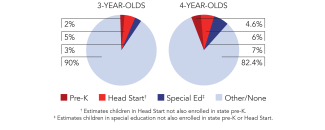
Total state pre-K enrollment 1,026 Special education enrollment, ages 3 and 4 1,925 Federally funded Head Start enrollment, ages 3 and 4 1,745 State-funded Head Start enrollment, ages 3 and 4 0 Resources
Total state pre-K spending $7,590,165 State Head Start spending $0 State spending per child enrolled $7,398 All reported spending per child enrolled* $7,398 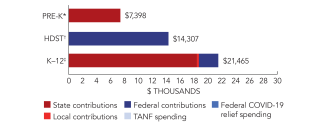
*Pre-K programs may receive additional funds from federal or local sources that are not included in this figure. †Head Start per-child spending includes funding only for 3- and 4-year-olds. ‡K–12 expenditures include capital spending as well as current operating expenditures.
-
Access
Resources
Total state pre-K spending $6,184,769 Local match required? No State spending per child enrolled $8,127 All reported spending per child enrolled* $8,127 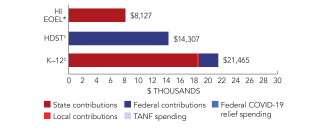
*Pre-K programs may receive additional funds from federal or local sources that are not included in this figure. †Head Start per-child spending includes funding only for 3- and 4-year-olds. ‡K–12 expenditures include capital spending as well as current operating expenditures.
Hawaii's Executive Office on Early Learning Public Prekindergarten Quality Standards Checklist
| Policy | HI EOEL Requirement | Benchmark | Meets Benchmark? |
|---|---|---|---|
For more information about the benchmarks, see the Executive Summary and the Roadmap to State pages. | 10benchmarks met | ||
| Early Learning & Development Standards Benchmark | Comprehensive, aligned, supported, culturally sensitive | Comprehensive, aligned, supported, culturally sensitive | |
| Curriculum Supports Benchmark | Approval process & supports | Approval process & supports | |
| Teacher Degree Benchmark | BA | BA | |
| Teacher Specialized Training Benchmark | ECE, CD | Specializing in pre-K | |
| Assistant Teacher Degree Benchmark | CDA | CDA or equivalent | |
| Staff Professional Development Benchmark | 10 PD sessions/year (teachers & assistants); PD plans; Coaching | For teachers & assistants: At least 15 hours/year; individual PD plans; coaching | |
| Maximum Class Size Benchmark | 20 (3- & 4-year-olds) | 20 or lower | |
| Staff to Child Ratio Benchmark | 1:10 (3- & 4-year-olds) | 1:10 or better | |
| Screening & Referral Benchmark | Full physical exam (includes vision & hearing); Referrals | Vision, hearing & health screenings; & referral | |
| Continuous Quality Improvement System Benchmark | Structured classroom observations; Data used for program improvement | Structured classroom observations; data used for program improvement | |
-
Access
Resources
Total state pre-K spending $1,405,396 Local match required? No State spending per child enrolled $5,303 All reported spending per child enrolled* $5,303 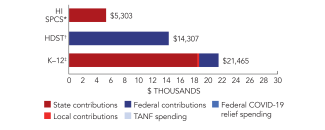
*Pre-K programs may receive additional funds from federal or local sources that are not included in this figure. †Head Start per-child spending includes funding only for 3- and 4-year-olds. ‡K–12 expenditures include capital spending as well as current operating expenditures.
Hawaii State Public Charter School Early Learning Program Quality Standards Checklist
| Policy | HI SPCSP Requirement | Benchmark | Meets Benchmark? |
|---|---|---|---|
For more information about the benchmarks, see the Executive Summary and the Roadmap to State pages. | 10*benchmarks met | ||
| Early Learning & Development Standards Benchmark | Comprehensive, aligned, supported, culturally sensitive | Comprehensive, aligned, supported, culturally sensitive | |
| Curriculum Supports Benchmark | Approval process & supports | Approval process & supports | |
| Teacher Degree Benchmark | BA* | BA | |
| Teacher Specialized Training Benchmark | ECE, CD | Specializing in pre-K | |
| Assistant Teacher Degree Benchmark | CDA | CDA or equivalent | |
| Staff Professional Development Benchmark | 60 hours/year (teachers & assistants); PD plans, Coaching | For teachers & assistants: At least 15 hours/year; individual PD plans; coaching | |
| Maximum Class Size Benchmark | 20 (3- & 4-year-olds) | 20 or lower | |
| Staff to Child Ratio Benchmark | 1:10 (3- & 4-year-olds) | 1:10 or better | |
| Screening & Referral Benchmark | Full physical exam (includes vision & hearing); Referrals | Vision, hearing & health screenings; & referral | |
| Continuous Quality Improvement System Benchmark | Structured classroom observations; Data used for program improvement | Structured classroom observations; data used for program improvement | |
* Indicates that while policy meets the benchmark, it is not being implemented fully
